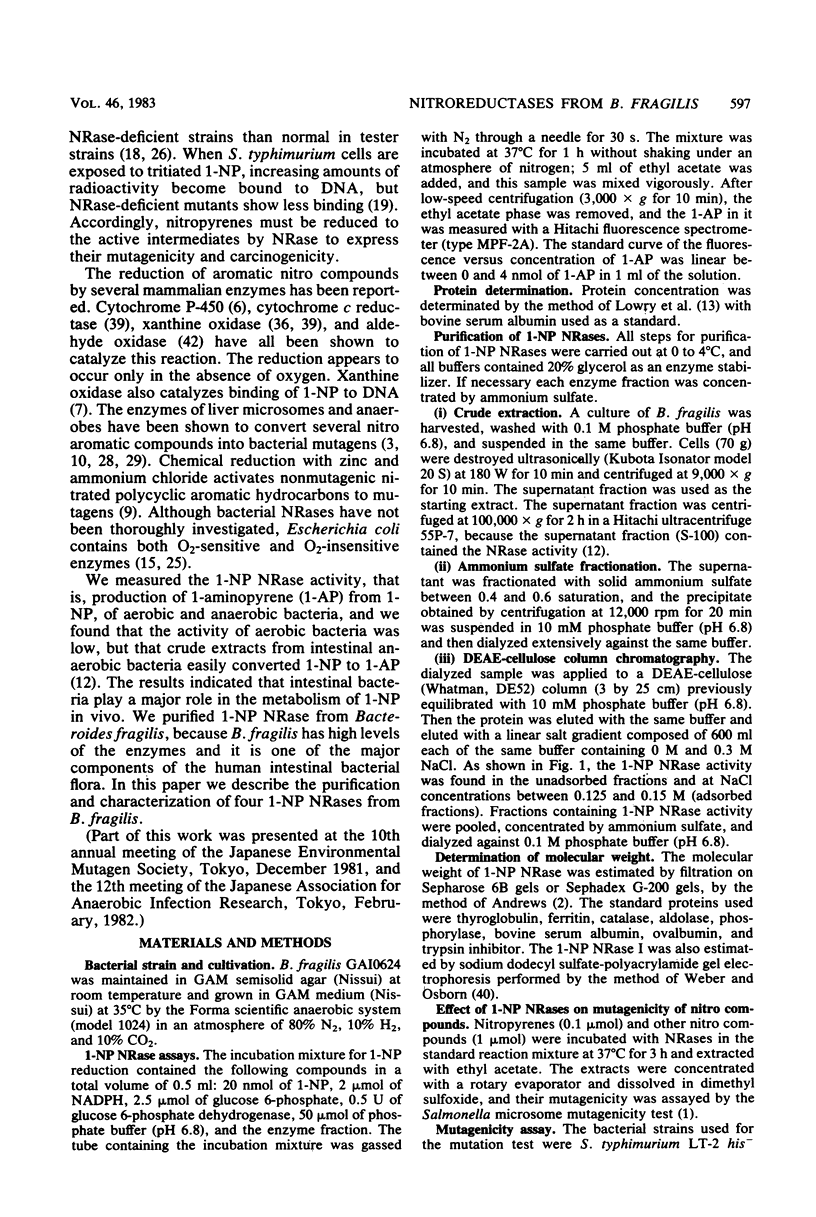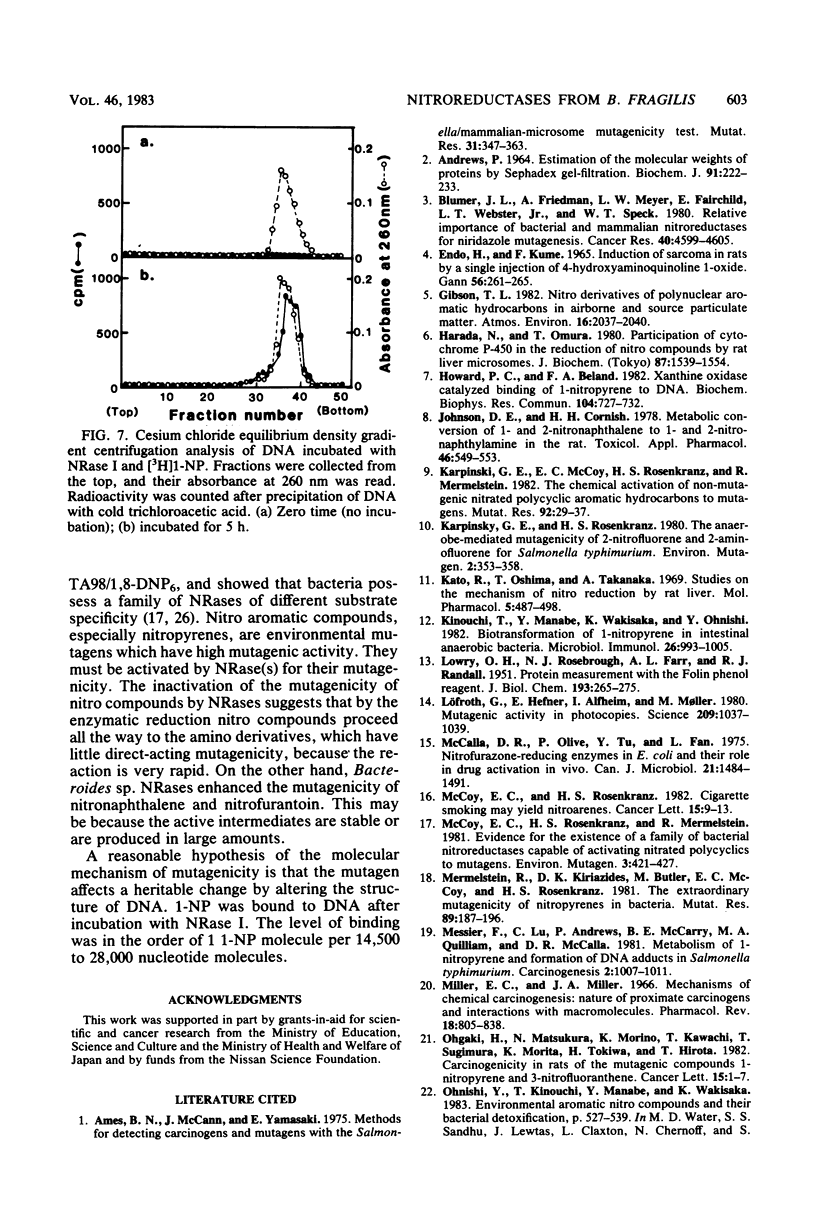Abstract
We isolated four nitroreductases from Bacteroides fragilis GAI0624 and examined their physicochemical and functional properties. Two major enzyme activities were found in the adsorbed and unadsorbed fractions from DEAE-cellulose column chromatography. The adsorbed fraction was subjected to Sephadex G-200 column chromatography, and two further activities were separated. One has high nitroreductase activity (nitroreductase I), and the other has low activity and relatively high molecular weight (nitroreductase III). The nitroreductase I fraction was subjected to hydroxylapatite and chromatofocusing column chromatography, and nitroreductase I was purified about 416-fold with a yield of 6.77%. The unadsorbed fraction from DEAE-cellulose column chromatography was subjected to Sepharose 2B and Sepharose 6B column chromatography. Two enzyme activities were obtained by the Sepharose 6B column chromatography. One has high activity (nitroreductase II), and the other has low activity (nitroreductase IV). Nitroreductase II was rechromatographed by Sepharose 6B gel filtration and purified about 178-fold with a yield of 9.65%. The four enzymes (nitroreductases I, II, III, and IV) were shown to be different by several criteria. Their molecular weights, determined by gel filtration, were 52,000, 320,000, 180,000, and 680,000, respectively. The substrate specificity, the effect on mutagenicity of mutagenic nitro compounds, of nitroreductases I, III, and IV was relatively high for 1-nitropyrene, dinitropyrenes, and 4-nitroquinoline 1-oxide, respectively, but nitroreductase II had broad specificity. Nitroreductase activity required a coenzyme; nitroreductases II, III, and IV were NADPH linked, but nitroreductase I was NADH linked. All enzyme activity was enhanced by addition of flavin mononucleotide and inhibited significantly by dicumarol, p-chloromercuribenzoic acid, o-iodosobenzoic acid, sodium azide, and Cu2+.(ABSTRACT TRUNCATED AT 250 WORDS)
Full text
PDF








Images in this article
Selected References
These references are in PubMed. This may not be the complete list of references from this article.
- Ames B. N., Mccann J., Yamasaki E. Methods for detecting carcinogens and mutagens with the Salmonella/mammalian-microsome mutagenicity test. Mutat Res. 1975 Dec;31(6):347–364. doi: 10.1016/0165-1161(75)90046-1. [DOI] [PubMed] [Google Scholar]
- Andrews P. Estimation of the molecular weights of proteins by Sephadex gel-filtration. Biochem J. 1964 May;91(2):222–233. doi: 10.1042/bj0910222. [DOI] [PMC free article] [PubMed] [Google Scholar]
- Blumer J. L., Friedman A., Meyer L. W., Fairchild E., Webster L. T., Jr, Speck W. T. Relative importance of bacterial and mammalian nitroreductases for niridazole mutagenesis. Cancer Res. 1980 Dec;40(12):4599–4605. [PubMed] [Google Scholar]
- Endo H., Kume F. Induction of sarcoma in rats by a single injection of 4-hydroxyaminoquinoline 1-oxide. Gan. 1965 Jun;56(3):261–265. [PubMed] [Google Scholar]
- Harada N., Omura T. Participation of cytochrome P-450 in the reduction of nitro compounds by rat liver microsomes. J Biochem. 1980 May;87(5):1539–1554. doi: 10.1093/oxfordjournals.jbchem.a132895. [DOI] [PubMed] [Google Scholar]
- Howard P. C., Beland F. A. Xanthine oxidase catalyzed binding of 1-nitropyrene to DNA. Biochem Biophys Res Commun. 1982 Jan 29;104(2):727–732. doi: 10.1016/0006-291x(82)90697-0. [DOI] [PubMed] [Google Scholar]
- Johnson D. E., Cornish H. H. Metabolic conversion of 1- and 2-nitronaphthalene to 1- and 2-naphthylamine in the rat. Toxicol Appl Pharmacol. 1978 Dec;46(3):549–573. doi: 10.1016/0041-008x(78)90302-2. [DOI] [PubMed] [Google Scholar]
- Karpinsky G. E., McCoy E. C., Rosenkranz H. S., Mermelstein R. The chemical activation of non-mutagenic nitrated polycyclic aromatic hydrocarbons to mutagens. Mutat Res. 1982 Feb 22;92(1-2):29–37. doi: 10.1016/0027-5107(82)90207-x. [DOI] [PubMed] [Google Scholar]
- Karpinsky G. E., Rosenkranz H. S. The anaerobe-mediated mutagenicity of 2-nitrofluorene and 2-aminofluorene for Salmonella typhimurium. Environ Mutagen. 1980;2(3):353–358. doi: 10.1002/em.2860020305. [DOI] [PubMed] [Google Scholar]
- Kato R., Oshima T., Takanaka A. Studies on the mechanism of nitro reduction by rat liver. Mol Pharmacol. 1969 Sep;5(5):487–498. [PubMed] [Google Scholar]
- Kinouchi T., Manabe Y., Wakisaka K., Ohnishi Y. Biotransformation of 1-nitropyrene in intestinal anaerobic bacteria. Microbiol Immunol. 1982;26(11):993–1005. doi: 10.1111/j.1348-0421.1982.tb00249.x. [DOI] [PubMed] [Google Scholar]
- LOWRY O. H., ROSEBROUGH N. J., FARR A. L., RANDALL R. J. Protein measurement with the Folin phenol reagent. J Biol Chem. 1951 Nov;193(1):265–275. [PubMed] [Google Scholar]
- Löfroth G., Hefner E., Alfheim I., Møoller M. Mutagenic activity in photocopies. Science. 1980 Aug 29;209(4460):1037–1039. doi: 10.1126/science.6996094. [DOI] [PubMed] [Google Scholar]
- McCalla D. R., Olive P., Tu Y., Fan M. L. Nitrofurazone-reducing enzymes in E. coli and their role in drug activation in vivo. Can J Microbiol. 1975 Oct;21(10):1484–1491. doi: 10.1139/m75-220. [DOI] [PubMed] [Google Scholar]
- McCoy E. C., Rosenkranz H. S. Cigarette smoking may yield nitroarenes. Cancer Lett. 1982 Jan;15(1):9–13. doi: 10.1016/0304-3835(82)90069-6. [DOI] [PubMed] [Google Scholar]
- McCoy E. C., Rosenkranz H. S., Mermelstein R. Evidence for the existence of a family of bacterial nitroreductases capable of activating nitrated polycyclics to mutagens. Environ Mutagen. 1981;3(4):421–427. doi: 10.1002/em.2860030403. [DOI] [PubMed] [Google Scholar]
- Mermelstein R., Kiriazides D. K., Butler M., McCoy E. C., Rosenkranz H. S. The extraordinary mutagenicity of nitropyrenes in bacteria. Mutat Res. 1981 Jul;89(3):187–196. doi: 10.1016/0165-1218(81)90236-6. [DOI] [PubMed] [Google Scholar]
- Messier F., Lu C., Andrews P., McCarry B. E., Quilliam M. A., McCalla D. R. Metabolism of 1-nitropyrene and formation of DNA adducts in Salmonella typhimurium. Carcinogenesis. 1981;2(10):1007–1011. doi: 10.1093/carcin/2.10.1007. [DOI] [PubMed] [Google Scholar]
- Miller E. C., Miller J. A. Mechanisms of chemical carcinogenesis: nature of proximate carcinogens and interactions with macromolecules. Pharmacol Rev. 1966 Mar;18(1):805–838. [PubMed] [Google Scholar]
- OTSUKA S. Studies on nitro-reducing enzymes of swine liver. Properties and cofactor requirements of nitro- and nitro-soreductases. J Biochem. 1961 Aug;50:85–94. doi: 10.1093/oxfordjournals.jbchem.a127427. [DOI] [PubMed] [Google Scholar]
- Ohgaki H., Matsukura N., Morino K., Kawachi T., Sugimura T., Morita K., Tokiwa H., Hirota T. Carcinogenicity in rats of the mutagenic compounds 1-nitropyrene and 3-nitrofluoranthene. Cancer Lett. 1982 Jan;15(1):1–7. doi: 10.1016/0304-3835(82)90068-4. [DOI] [PubMed] [Google Scholar]
- Pederson T. C., Siak J. S. The role of nitroaromatic compounds in the direct-acting mutagenicity of diesel particle extracts. J Appl Toxicol. 1981 Apr;1(2):54–60. doi: 10.1002/jat.2550010203. [DOI] [PubMed] [Google Scholar]
- Peterson F. J., Mason R. P., Hovsepian J., Holtzman J. L. Oxygen-sensitive and -insensitive nitroreduction by Escherichia coli and rat hepatic microsomes. J Biol Chem. 1979 May 25;254(10):4009–4014. [PubMed] [Google Scholar]
- Rosenkranz H. S., McCoy E. C., Mermelstein R., Speck W. T. A cautionary note the use of nitroreductase-deficient strains of Salmonella typhimurium for the detection of nitroarenes as mutagens in complex mixtures including diesel exhausts. Mutat Res. 1981 Mar;91(2):103–105. doi: 10.1016/0165-7992(81)90080-4. [DOI] [PubMed] [Google Scholar]
- Rosenkranz H. S., McCoy E. C., Sanders D. R., Butler M., Kiriazides D. K., Mermelstein R. Nitropyrenes: isolation, identificaton, and reduction of mutagenic impurities in carbon black and toners. Science. 1980 Aug 29;209(4460):1039–1043. doi: 10.1126/science.6996095. [DOI] [PubMed] [Google Scholar]
- Rosenkranz H. S., Speck W. T. Activation of nitrofurantoin to a mutagen by rat liver nitroreductase. Biochem Pharmacol. 1976 Jul 1;25(13):1555–1556. doi: 10.1016/0006-2952(76)90080-0. [DOI] [PubMed] [Google Scholar]
- Rosenkranz H. S., Speck W. T. Mutagenicity of metronidazole: activation by mammalian liver microsomes. Biochem Biophys Res Commun. 1975 Sep 16;66(2):520–525. doi: 10.1016/0006-291x(75)90541-0. [DOI] [PubMed] [Google Scholar]
- SAITO H., MIURA K. I. PREPARATION OF TRANSFORMING DEOXYRIBONUCLEIC ACID BY PHENOL TREATMENT. Biochim Biophys Acta. 1963 Aug 20;72:619–629. [PubMed] [Google Scholar]
- SHIRASU Y. FURTHER STUDIES ON CARCINOGENIC ACTION OF 4-HYDROXYAMINOQUINOLINE 1-OXIDE. Gan. 1963 Dec;54:487–495. [PubMed] [Google Scholar]
- Salmeen I., Durisin A. M., Prater T. J., Riley T., Schuetzle D. Contribution of 1-nitropyrene to direct-acting Ames assay mutagenicities of diesel particulate extracts. Mutat Res. 1982 Apr;104(1-3):17–23. doi: 10.1016/0165-7992(82)90114-2. [DOI] [PubMed] [Google Scholar]
- Sugimura T., Okabe K., Endo H. The metabolism of 4-nitroquinoline 1-oxide. I. Conversion of 4-nitroquinoline 1-oxide to 4-aminoquinoline 1-oxide by rat liver enzymes. Gan. 1965 Oct;56(5):489–501. [PubMed] [Google Scholar]
- Sugimura T., Okabe K., Nagao M. The metabolism of 4-nitroquinoline-1-oxide, a carcinogen. 3. An enzyme catalyzing the conversion of 4-nitroquinoline-1-oxide to 4-hydroxyaminoquinoline-1-oxide in rat liver and hepatomas. Cancer Res. 1966 Aug;26(8):1717–1721. [PubMed] [Google Scholar]
- TAYLOR J. D., PAUL H. E., PAUL M. F. Metabolism of the nitrofurans. III. Studies with xanthine oxidase in vitro. J Biol Chem. 1951 Jul;191(1):223–231. [PubMed] [Google Scholar]
- Tatsumi K., Doi T., Yoshimura H., Koga H., Horiuchi T. Oxygen--insensitive nitrofuran reductases in Salmonella typhimurium TA100. J Pharmacobiodyn. 1982 Jun;5(6):423–429. doi: 10.1248/bpb1978.5.423. [DOI] [PubMed] [Google Scholar]
- Tokiwa H., Nakagawa R., Morita K., Ohnishi Y. Mutagenicity of nitro derivatives induced by exposure of aromatic compounds to nitrogen dioxide. Mutat Res. 1981 Aug;85(4):195–205. doi: 10.1016/0165-1161(81)90036-4. [DOI] [PubMed] [Google Scholar]
- Tu Y., McCalla D. R. Effect of activated nitrofurans on DNA. Biochim Biophys Acta. 1975 Aug 21;402(2):142–149. doi: 10.1016/0005-2787(75)90032-5. [DOI] [PubMed] [Google Scholar]
- Wang C. Y., Behrens B. C., Ichikawa M., Bryan G. T. Nitroreduction of 5-nitrofuran derivatives by rat liver xanthine oxidase and reduced nicotinamide adenine dinucleotide phosphate-cytochrome c reductase. Biochem Pharmacol. 1974 Dec 15;23(24):3395–3404. doi: 10.1016/0006-2952(74)90342-6. [DOI] [PubMed] [Google Scholar]
- Weber K., Osborn M. The reliability of molecular weight determinations by dodecyl sulfate-polyacrylamide gel electrophoresis. J Biol Chem. 1969 Aug 25;244(16):4406–4412. [PubMed] [Google Scholar]
- Weisburger J. H., Weisburger E. K. Biochemical formation and pharmacological, toxicological, and pathological properties of hydroxylamines and hydroxamic acids. Pharmacol Rev. 1973 Mar;25(1):1–66. [PubMed] [Google Scholar]
- Wolpert M. K., Althaus J. R., Johns D. G. Nitroreductase activity of mammalian liver aldehyde oxidase. J Pharmacol Exp Ther. 1973 May;185(2):202–213. [PubMed] [Google Scholar]
- Zachariah P. K., Juchau M. R. The role of gut flora in the reduction of aromatic nitro-groups. Drug Metab Dispos. 1974 Jan-Feb;2(1):74–78. [PubMed] [Google Scholar]



